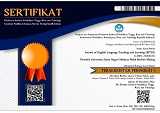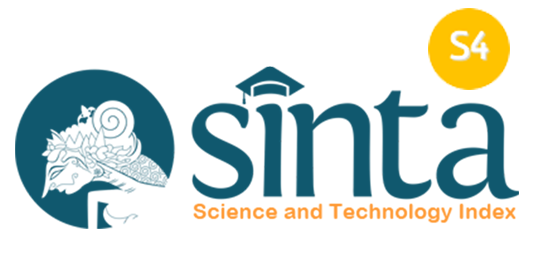A Pragmatic Analysis of Efl Learners’ Social Media Interaction
Abstract
As a new and emerging venue of interaction, social media provide an ample opportunity for EFL learners to practice their English mastery and to enhance their socio-pragmatic awareness. However, even though some social media attempt to accommodate and mimic offline communications through their features, there are still technological and platform affordance and constraints that limit what users can do to get their message across. This situation makes a pragmatic analysis of online communication using offline measure a naïve endeavor. To confirm this notion, this paper borrows concepts from relevance theory pertaining to L1 and L2 pragmatics to reveal the patterns of online communication of 43 EFL learners in their social media interaction. The results show that there is a different pattern between online and offline interaction where they share a non-prototypical model of communication, the process of context and meaning construction, as well as their attempt to compensate for what the platform is lacking in accommodating their communication need.
Full Text:
PDFReferences
Alshenqeeti, H., (2016). Are emojis creating a new or old visual language for new generations? A socio- semiotic study. Advanced Language and Literature Study 7, 56–69. https://doi.org/10.7575/aiac.alls.v.7n.6p.56.
Berglund, T.Ӧ., (2009). Disrupted turn adjacency and coherence maintenance in instant messaging conversations. Language@Internet. 6 Article 2.
Blattner, G., & Fiori, M. (2011). Virtual Social Network Communities: An Investigation of Language Learners’ Development of Sociopragmatic Awareness and Multiliteracy Skills. CALICO Journal,29(1), 24-43. doi:10.11139/cj.29.1.24-43
Cohen, A. D. (2008). Teaching and assessing L2 pragmatics: What can we expect from learners? Language Teaching,41(02). doi:10.1017/s0261444807004880
Cook, V. (2016). Second Language Learning and Language Teaching. New York: Routledge.
Derks, D., Fischer, A. H., & Bos, A. E. (2008). The role of emotion in computer mediated communication: A review. Computers in Human Behavior, 24, 766–785.
Devitt, M., & Henley, R. (2003). Speech Acts and Pragmatics. In Blackwell Guide to the Philosophy of Language.
Dresner, E., & Herring, S. C. (2010). Functions of the Nonverbal in CMC: Emoticons and Illocutionary Force. Communication Theory,20(3), 249-268. doi:10.1111/j.1468-2885.2010.01362.x
Eslami, Z. R. (2013). Online communication and students’ pragmatic choices in English. Lodz Papers in Pragmatics,9(1). doi:10.1515/lpp-2013-0005
Harting, A. (2017). Using Facebook to improve L2 German students’ socio-pragmatic skills. The EuroCALL Review,25(1), 26. doi:10.4995/eurocall.2017.7014
Herring, S.C., (1999). Interactional coherence in CMC. Journal of Computer Mediated Communication. 4 (4) Retrieved from http://www.ascusc.org/jcmc/vol4/issue4/herring.html
Ganster, T., Eimler, S. C., & Kramer, N. C. (2012). Same same but different!? The differential influence of smilies and emoticons on person perception. Cyberpsychology, Behaviour, and Social Networking, 15(4), 226-230.
Georgakopoulou, A. (2011). “On for drinkies?”: Email cues of participant alignments. Language@Internet, 8, article 4.
Lantz-Andersson, A. (2017). Language play in a second language: Social media as contexts for emerging Sociopragmatic competence. Education and Information Technologies,23(2), 705-724. doi:10.1007/s10639-017-9631-0
Locher, M. A. (n.d.). 14. Internet advice. Pragmatics of Computer-Mediated Communication. doi:10.1515/9783110214468.339
Martí, N. M., & Fernández, S. S. (2016). Telecollaboration and sociopragmatic awareness in the foreign language classroom. Innovation in Language Learning and Teaching,10(1), 34-48. doi:10.1080/17501229.2016.1138577
Miller, Vincent. (2008). New media, networking and phatic culture. Convergence 14(4): 387–400.
Nishimaki, K,. (2014). Characteristics of Spoken and Written Communication in the Opening and Closing Sections of Instant Messaging. Dissertations and Theses.
O'Malley, J. M., & Pierce, L. V. (1996). Authentic assessment for English language learners: Practical approaches for teachers. Reading, Mass: Addison-Wesley Pub. Co.
Reinhardt, J., & Ryu, J. (n.d.). Using Social Network-Mediated Bridging Activities to Develop Socio-Pragmatic Awareness in Elementary Korean. Computational Linguistics, 561-577. doi:10.4018/978-1-4666-6042-7.ch026
Riordan, M.A., (2017). Emojis as tools for emotion work: communicating affect in text messages. Journal of Language And Social Psychology. 36, 0261927X1770423. https://doi.org/10.1177/0261927X17704238.
Wendy L. Bowcher & Junyu Zhang. (2017). Spoken and written discourse in online interactions: a multimodal approach (Routledge studies in multimodality). Learning, Media and Technology, 42:2, 251-255, DOI: 10.1080/17439884.2014.988160
Yus, F. (2014). Not All Emoticons Are Created Equal. Linguagem Em (Dis)curso,14(3), 511-529. doi:10.1590/1982-4017-140304-0414
Yus, F. (2018). The interface between pragmatics and internet-mediated communication. Pragmatics and its Interfaces. 294, 267
DOI: https://doi.org/10.18860/jetle.v1i1.7751
Refbacks
- There are currently no refbacks.
Jalan Gajayana 50 Malang 65144, Jawa Timur, Indonesia

This work is licensed under a Creative Commons Attribution-ShareAlike 4.0 International License.
Indexed by





